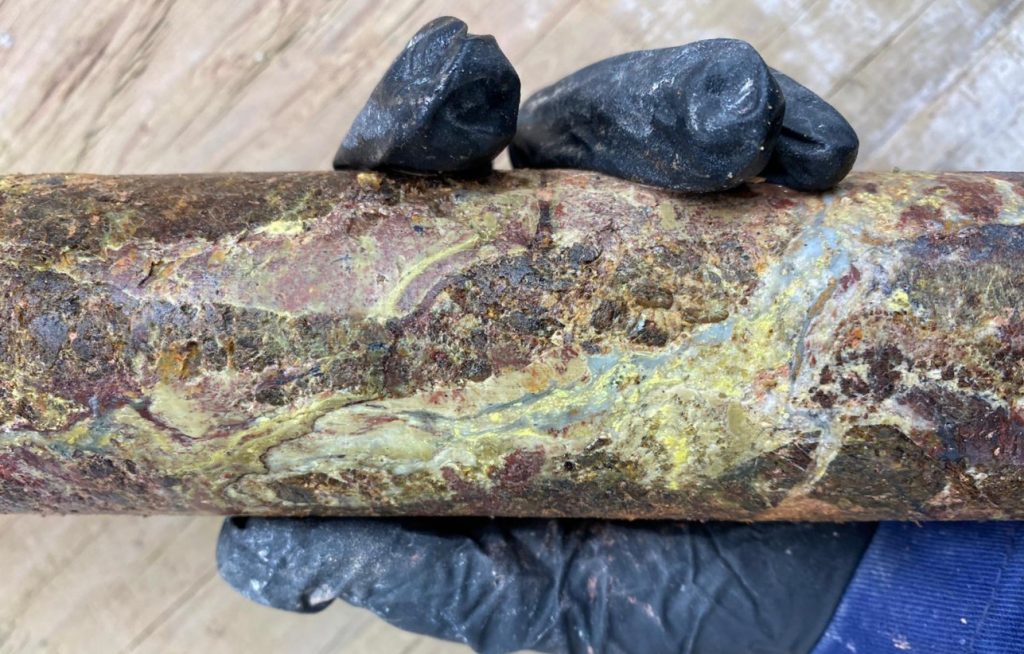Baselode Energy drills 490 ppm U3O8 1.9 metres at Hook, Saskatchewan

Baselode Energy Corp. [TSXV-FIND; OTCQB-BSENF] reported final uranium (triuranium octoxide (U3O8)) assays from six exploration drill holes outside of the Ackio uranium prospect from the 7,512-metre diamond drilling program completed on the Hook project, northern Saskatchewan.
“We’ve discovered new anomalous uranium on untested ground east of Ackio on Hook. Our geological understanding of the project has evolved with the discovery and ongoing delineation of Ackio, and we believe the broader Hook project has excellent potential for additional deposits. The results from these preliminary exploration drill holes encourage us to further test the project-scale fertile structure that hosts Ackio. In addition to the Mirror and Sandstone targets, we will be drilling additional regional targets in 2024,” stated James Sykes, CEO, president and director of Baselode.
“A lot has been learned in the two years since Ackio was first discovered. Like other basement-hosted deposits Ackio is structurally controlled, but in our case our controlling structures are not conductive and are related to normal faulting focused along lithology contacts. It is encouraging to see anomalous uranium values at lithology contacts east of Ackio. Additionally, we have other targets on the Hook project which have similar geophysical signatures to Ackio,” said Cameron MacKay, vice-president, exploration and development.
Thirty-six drill holes for 7,512 metres were completed during the program. Ackio consisted of 30 drill holes for 6,193 metres, Mirror consisted of five drill holes for 1,145 metres and one drill hole for 174 metres was completed on a regional exploration target.
The Mirror target area consisted of drill holes AK23-105 to AK23-109, which were designed as a broad fan of drill holes to test for uranium mineralization beyond the eastern limits of Ackio along an inferred subparallel structure. All five holes encountered hydrothermal alteration consisting of varying intensities of chlorite, hematite and clay across the entire drill hole lengths. Drill holes AK23-105 to AK23-107 intersected elevated uranium (that is, 190 parts per million U3O8 over 3 metres at 93.5 metres drill hole depth in AK23-107) that remains open in all directions.
AK23-105 returned 170 ppm U3O8 over 0.5 metres. AK23-106 returned 120 ppm over 0.2 metres. AK23107 returned 190 ppm over 3.0 metres and 120 ppm over 0.1 metres.
Drill hole AK23-110 was designed to test for unconformity uranium mineralization near the structural contact separating basement and sandstone rocks (the Sandstone target). The drill hole intersected one of the most anomalous sandstone columns for uranium and other pathfinder elements, suggesting the unconformity target has significant potential for uranium mineralization.
The drill hole also intersected encouraging uranium mineralization within the basement rocks only 16 metres from the unconformity (that is, 490 ppm U3O8 over 1.9 metres at 126.5 metres drill hole depth). The Sandstone target area is open to the south and along the eastern structural contact beyond where previous drill holes returned some of the strongest sandstone uranium and pathfinder anomalies.
Ackio is 30 km southeast of well-established infrastructure, including an all-season road and power line between Cameco’s and Orano’s McArthur River mine and Key Lake uranium mill joint ventures. Ackio is 70 km northeast of the Key Lake mill. The program was helicopter-supported to lessen any ground-induced environmental impacts within the project area.
Baselode controls 100% of approximately 264,172 hectares for exploration in the Athabasca basin area, Saskatchewan. The land package is free of any option agreements or underlying royalties.
The company discovered the Ackio near-surface, uranium prospect in September 2021. Ackio measures greater than 375 metres along strike, greater than 150 metres wide, comprising at least nine separate uranium Pods, with mineralization starting as shallow as 28 metres and 32 metres beneath the surface in pods 1 and 7, respectively, and down to approximately 300 metres depth beneath the surface with the bulk of mineralization occurring in the upper 120 metres. Ackio remains open at depth, and to the north, south and east.
Baselode’s Athabasca 2.0 exploration thesis focuses on discovering near-surface, basement-hosted, high-grade uranium orebodies outside the Athabasca basin. The exploration thesis is further complemented by the company’s preferred use of innovative and well-understood geophysical methods to map deep structural controls to identify shallow targets for diamond drilling.
